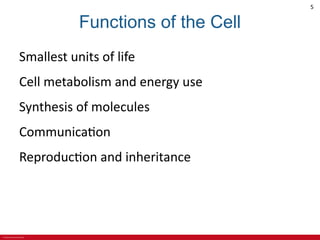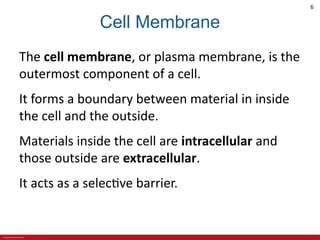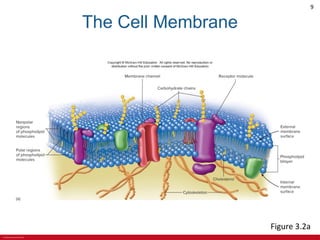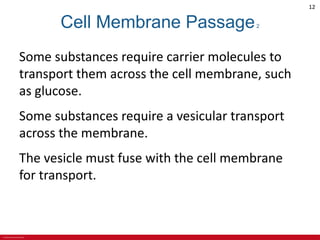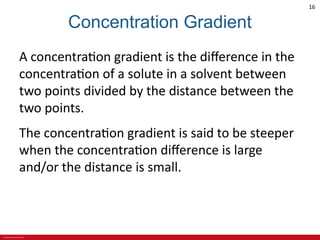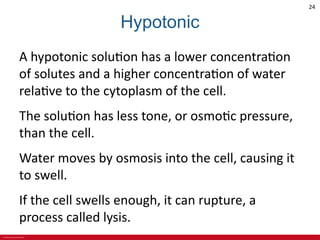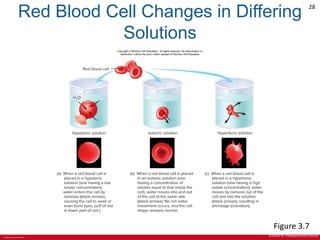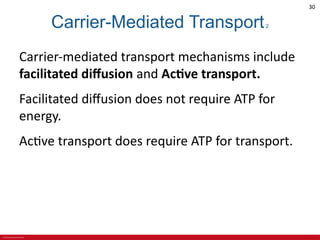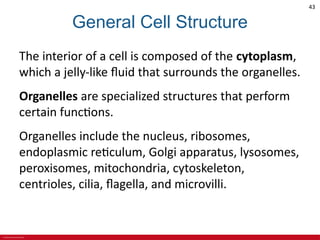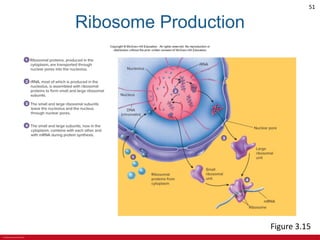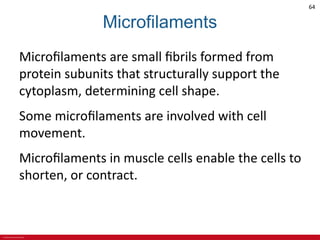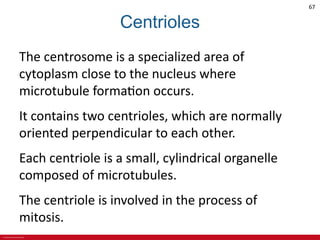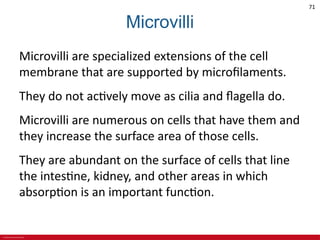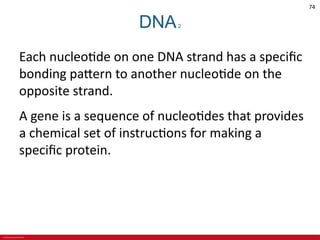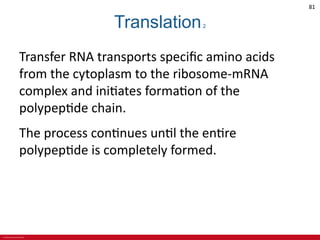CHAPTER 3 Cell Structures and Their Functions Lecture Outline.pdf
- 1. Seeley’s ESSENTIALS OF Anatomy & Physiology Tenth Edition Cinnamon Vanputte Jennifer Regan Andrew Russo See separate PowerPoint slides for all figures and tables pre-inserted into PowerPoint without notes. © 2019 McGraw-Hill Education. All rights reserved. Authorized only for instructor use in the classroom. No reproduction or further distribution permitted without the prior written consent of McGraw-Hill Education.
- 2. © 2019 McGraw-Hill Education 2 Chapter 3 Cell Structures and Their Functions Lecture Outline
- 3. © 2019 McGraw-Hill Education 3 Cell Structure Organelles: • specialized structures in cells that perform • specific functions • Example: nucleus, mitochondria, ribosomes Cytoplasm: • jelly-like substance that holds organelles Cell membrane: • also termed the plasma membrane • a structure that encloses the cytoplasm
- 4. © 2019 McGraw-Hill Education 4 Generalized Cell1 Figure 3.1
- 5. © 2019 McGraw-Hill Education 5 Functions of the Cell Smallest units of life Cell metabolism and energy use Synthesis of molecules Communication Reproduction and inheritance
- 6. © 2019 McGraw-Hill Education 6 Cell Membrane The cell membrane, or plasma membrane, is the outermost component of a cell. It forms a boundary between material in inside the cell and the outside. Materials inside the cell are intracellular and those outside are extracellular. It acts as a selective barrier.
- 7. © 2019 McGraw-Hill Education 7 Cell Membrane Structure The fluid-mosaic model is the model used to describe the cell membrane structure. The membrane contains phospholipids, cholesterol, proteins, and carbohydrates. Phospholipids form a bilayer. Phospholipids contain 2 regions: polar and nonpolar.
- 8. © 2019 McGraw-Hill Education 8 Phospholipid Structure A phospholipid molecule has a polar head region that is hydrophilic and a nonpolar tail region that is hydrophobic. The polar region is exposed to water around the membrane. The nonpolar region is facing the interior of the membrane.
- 9. © 2019 McGraw-Hill Education 9 The Cell Membrane Figure 3.2a
- 10. © 2019 McGraw-Hill Education 10 Movement through the Cell Membrane The cell membrane has selective permeability, which allows only certain substances to pass in and out of the cell. Substances such as enzymes, glycogen, and potassium are found in higher concentrations inside the cell. Substances such as sodium, calcium, and chloride are found in higher concentrations outside the cell.
- 11. © 2019 McGraw-Hill Education 11 Cell Membrane Passage1 Some substances, like O2 and CO2, can pass directly through the cell membrane’s phospholipid bilayer. Some substances must pass through transmembrane protein channels, such as Na+ through its channels. The route of transport through the membrane depends on the size, shape, and charge of the substance.
- 12. © 2019 McGraw-Hill Education 12 Cell Membrane Passage2 Some substances require carrier molecules to transport them across the cell membrane, such as glucose. Some substances require a vesicular transport across the membrane. The vesicle must fuse with the cell membrane for transport.
- 13. © 2019 McGraw-Hill Education 13 Active Transport and Passive Transport1 Passive membrane transport does not require the cell to expend energy. Active membrane transport does require the cell to expend energy, usually in the form of ATP.
- 14. © 2019 McGraw-Hill Education 14 Active Transport and Passive Transport2 Passive membrane transport mechanisms include diffusion, osmosis, and facilitated diffusion. Active membrane transport mechanisms include active transport, secondary active transport, endocytosis, and exocytosis.
- 15. © 2019 McGraw-Hill Education 15 Diffusion1 Diffusion generally involves movement of substances in a solution down a concentration gradient. A solution is generally composed of two major parts, solutes and the solvent. Solutes are substances dissolved in a predominant liquid or gas, which is called the solvent. Solutes, such as ions or molecules, tend to move from an area of higher concentration of a solute to an area of lower concentration of that same solute in solution. This movement from high concentration to a low concentration is diffusion.
- 16. © 2019 McGraw-Hill Education 16 Concentration Gradient A concentration gradient is the difference in the concentration of a solute in a solvent between two points divided by the distance between the two points. The concentration gradient is said to be steeper when the concentration difference is large and/or the distance is small.
- 17. © 2019 McGraw-Hill Education 17 Diffusion2 Figure 3.3
- 18. © 2019 McGraw-Hill Education 18 Leak and Gated Channels1 Lipid soluble substances can diffuse directly through the phospholipid bilayer. Water-soluble substances, such as ions, can diffuse across the cell membrane only by passing through cell membrane channels.
- 19. © 2019 McGraw-Hill Education 19 Leak and Gated Channels2 Two classes of cell membrane channels include leak channels and gated channels. Leak channels constantly allow ions to pass through. Gated channels limit the movement of ions across the membrane by opening and closing.
- 20. © 2019 McGraw-Hill Education 20 Diffusion through the Cell Membrane Figure 3.4
- 21. © 2019 McGraw-Hill Education 21 Leak and Gated Membrane Channels Figure 3.5
- 22. © 2019 McGraw-Hill Education 22 Osmosis1 Osmosis is the diffusion of water (a solvent) across a selectively permeable membrane from a region of higher water concentration to one of lower water concentration. Osmosis exerts a pressure, termed osmotic pressure, which is the force required to prevent movement of water across cell membrane
- 23. © 2019 McGraw-Hill Education 23 Osmotic Pressure and the Cell Osmotic pressure depends on the difference of solution concentrations inside a cell relative to outside the cell. A cell may be placed in solutions that are either hypotonic, isotonic, or hypertonic compared to the cell cytoplasm.
- 24. © 2019 McGraw-Hill Education 24 Hypotonic A hypotonic solution has a lower concentration of solutes and a higher concentration of water relative to the cytoplasm of the cell. The solution has less tone, or osmotic pressure, than the cell. Water moves by osmosis into the cell, causing it to swell. If the cell swells enough, it can rupture, a process called lysis.
- 25. © 2019 McGraw-Hill Education 25 Isotonic A cell immersed in an isotonic solution has the same solute concentrations inside and outside the cell. The cell will neither shrink nor swell.
- 26. © 2019 McGraw-Hill Education 26 Hypertonic The cytoplasm of a cell in a hypertonic solution has a lower solute concentration and higher water concentration than the surrounding solution. Water moves by osmosis from the cell into the hypertonic solution, resulting in cell shrinkage, or crenation.
- 27. © 2019 McGraw-Hill Education 27 Osmosis2
- 28. © 2019 McGraw-Hill Education 28 Red Blood Cell Changes in Differing Solutions Figure 3.7 ©David M. Phillips/Science Source
- 29. © 2019 McGraw-Hill Education 29 Carrier-Mediated Transport1 Some water-soluble, electrically charged or large sized particles cannot enter or leave through the cell membrane by diffusion. These substances include amino acids, glucose, and some polar molecules produced by the cell. Carrier molecules are proteins within the cell membrane involved in carrier-mediated transport.
- 30. © 2019 McGraw-Hill Education 30 Carrier-Mediated Transport2 Carrier-mediated transport mechanisms include facilitated diffusion and Active transport. Facilitated diffusion does not require ATP for energy. Active transport does require ATP for transport.
- 31. © 2019 McGraw-Hill Education 31 Facilitated Diffusion1 Facilitated diffusion is a carrier-mediated transport process that moves substances across the cell membrane from an area of higher concentration to an area of lower concentration of that substance. Because movement is with the concentration gradient, metabolic energy in the form of ATP is not required.
- 32. © 2019 McGraw-Hill Education 32 Facilitated Diffusion2 Figure 3.8
- 33. © 2019 McGraw-Hill Education 33 Active Transport Active transport is a carrier-mediated process, requiring ATP, that moves substances across the cell membrane from regions of lower concentration to those of higher concentration against a concentration gradient. Active transport processes accumulate necessary substances on one side of the cell membrane at concentrations many times greater than those on the other side.
- 34. © 2019 McGraw-Hill Education 34 Sodium-Potassium Pump1 A major example of active transport is the action of the sodium-potassium pump present in cell membranes. The sodium-potassium pump moves Na+ out of cells and K+ into cells. The result is a higher concentration of Na+ outside cells and a higher concentration of K+ inside cells.
- 35. © 2019 McGraw-Hill Education 35 Sodium-Potassium Pump2 Figure 3.9
- 36. © 2019 McGraw-Hill Education 36 Secondary Active Transport1 Secondary active transport uses the energy provided by a concentration gradient established by the active transport of one substance, such as Na+ to transport other substances. No additional energy is required above the energy provided by the initial active transport pump.
- 37. © 2019 McGraw-Hill Education 37 Secondary Active Transport2 In cotransport, the diffusing substance moves in the same direction as the initial active transported substance. In countertransport, the diffusing substance moves in a direction opposite to that of the initial active transported substance.
- 38. © 2019 McGraw-Hill Education 38 Secondary Active Transport3 Figure 3.10
- 39. © 2019 McGraw-Hill Education 39 Endocytosis Endocytosis is a process that that brings materials into cell using vesicles. Receptor-mediated endocytosis occurs when a specific substance binds to the receptor molecule and is transported into the cell. Phagocytosis is often used for endocytosis when solid particles are ingested. Pinocytosis has much smaller vesicles formed, and they contain liquid rather than solid particles.
- 40. © 2019 McGraw-Hill Education 40 Receptor-Mediated Endocytosis Figure 3.11
- 41. © 2019 McGraw-Hill Education 41 Exocytosis1 Exocytosis involves the use of membrane-bound sacs called secretory vesicles that accumulate materials for release from the cell. The vesicles move to the cell membrane and fuse, ultimately releasing the material by exocytosis. Examples of exocytosis are the secretion of digestive enzymes.
- 42. © 2019 McGraw-Hill Education 42 Exocytosis2 Figure 3.12 (b) ©Dr. Birgit H. Satir
- 43. © 2019 McGraw-Hill Education 43 General Cell Structure The interior of a cell is composed of the cytoplasm, which a jelly-like fluid that surrounds the organelles. Organelles are specialized structures that perform certain functions. Organelles include the nucleus, ribosomes, endoplasmic reticulum, Golgi apparatus, lysosomes, peroxisomes, mitochondria, cytoskeleton, centrioles, cilia, flagella, and microvilli.
- 44. © 2019 McGraw-Hill Education 44 Generalized Cell2 Figure 3.1
- 45. © 2019 McGraw-Hill Education 45 Cell Nucleus1 The nucleus is a large organelle usually located near the center of the cell. The nucleus is bounded by a nuclear envelope, which consists of outer and inner membranes with a narrow space between them. The nuclear membrane contains nuclear pores, through which materials can pass into or out of the nucleus.
- 46. © 2019 McGraw-Hill Education 46 Cell Nucleus2 The nuclei of human cells contain 23 pairs of chromosomes which consist of DNA and proteins. During most of a cell’s life, the chromosomes are loosely coiled and collectively called chromatin. When a cell prepares to divide, the chromosomes become tightly coiled and are visible when viewed with a microscope.
- 47. © 2019 McGraw-Hill Education 47 Cell Nucleus3 Within the nucleus are Nucleoli, which are diffuse bodies with no surrounding membrane. that are found within the nucleus There are usually one to several nucleoli within the nucleus. The subunits of ribosomes, a type of cytoplasmic organelle, are formed within a nucleolus. These ribosomal components exit the nucleus through nuclear pores.
- 48. © 2019 McGraw-Hill Education 48 Cell Nucleus4 Figure 3.13 (b,c) ©Don W. Fawcett/Science Source
- 49. © 2019 McGraw-Hill Education 49 Chromosome Structure Figure 3.14
- 50. © 2019 McGraw-Hill Education 50 Ribosomes Ribosome components are produced in the nucleolus. Ribosomes are the organelles where proteins are produced. Ribosomes may be attached to other organelles, such as the endoplasmic reticulum. Ribosomes that are not attached to any other organelle are called free ribosomes.
- 51. © 2019 McGraw-Hill Education 51 Ribosome Production Figure 3.15
- 52. © 2019 McGraw-Hill Education 52 Endoplasmic Reticulum1 The endoplasmic reticulum (ER) is a series of membranes forming sacs and tubules that extends from the outer nuclear membrane into the cytoplasm. The rough ER is involved in protein synthesis and is rough due to attached ribosomes. The smooth ER has no attached ribosomes and is a site for lipid synthesis, cellular detoxification, and it stores calcium ions in skeletal muscle cells.
- 53. © 2019 McGraw-Hill Education 53 Endoplasmic Reticulum2 Figure 3.16a
- 54. © 2019 McGraw-Hill Education 54 Golgi Apparatus1 The Golgi apparatus, also called the Golgi complex, consists of closely packed stacks of curved, membrane-bound sacs. It collects, modifies, packages, and distributes proteins and lipids manufactured by the ER. The Golgi apparatus forms vesicles, some of which are secretory vesicles, lysosomes, and other vesicles.
- 55. © 2019 McGraw-Hill Education 55 Golgi Apparatus2 Figure 3.13 (b) ©Biophoto Associates/Science Source
- 56. © 2019 McGraw-Hill Education 56 Lysosomes Lysosomes are membrane-bound vesicles formed from the Golgi apparatus. They contain a variety of enzymes that function as intracellular digestive systems. Vesicles formed by endocytosis may fuse with lysosomes in order to breakdown materials in the endocytotic vesicles. One example is white blood cells phagocytizing bacteria.
- 57. © 2019 McGraw-Hill Education 57 Lysosome Action Figure 3.18
- 58. © 2019 McGraw-Hill Education 58 Peroxisomes Peroxisomes are small, membrane-bound vesicles containing enzymes that break down fatty acids, amino acids, and hydrogen peroxide (H2O2). Hydrogen peroxide is a by-product of fatty acid and amino acid breakdown and can be toxic to a cell. The enzymes in peroxisomes break down hydrogen.
- 59. © 2019 McGraw-Hill Education 59 Mitochondria1 Mitochondria (singular mitochondrion) are small organelles responsible for producing considerable amounts of ATP by aerobic (with O2) metabolism. They have inner and outer membranes separated by a space. The outer membranes have a smooth contour, but the inner membranes have numerous folds, called cristae, which project into the interior of the mitochondria.
- 60. © 2019 McGraw-Hill Education 60 Mitochondria2 The material within the inner membrane is the mitochondrial matrix and contains enzymes and mitochondrial DNA (mtDNA). Cells with a large energy requirement have more mitochondria than cells that require less energy.
- 61. © 2019 McGraw-Hill Education 61 A Mitochondrion Figure 3.19 (b) ©EM Research Services, Newcastle University RF
- 62. © 2019 McGraw-Hill Education 62 The Cytoskeleton2 The cytoskeleton gives internal framework to the cell. It consists of protein structures that support the cell, hold organelles in place, and enable the cell to change shape. These protein structures are microtubules, microfilaments, and intermediate filaments.
- 63. © 2019 McGraw-Hill Education 63 Microtubules Microtubules are hollow structures formed from protein subunits. The microtubules perform a variety of roles, including helping to support the cytoplasm of cells, assisting in cell division, and forming essential components of certain organelles, such as cilia and flagella.
- 64. © 2019 McGraw-Hill Education 64 Microfilaments Microfilaments are small fibrils formed from protein subunits that structurally support the cytoplasm, determining cell shape. Some microfilaments are involved with cell movement. Microfilaments in muscle cells enable the cells to shorten, or contract.
- 65. © 2019 McGraw-Hill Education 65 Intermediate Filaments Intermediate filaments are fibrils formed from protein subunits that are smaller in diameter than microtubules but larger in diameter than microfilaments. They provide mechanical support to the cell. A specific type of intermediate filament is keratin, a protein associated with skin cells.
- 66. © 2019 McGraw-Hill Education 66 The Cytoskeleton1 Figure 3.20 (b) ©Don Fawcett/Science Source
- 67. © 2019 McGraw-Hill Education 67 Centrioles The centrosome is a specialized area of cytoplasm close to the nucleus where microtubule formation occurs. It contains two centrioles, which are normally oriented perpendicular to each other. Each centriole is a small, cylindrical organelle composed of microtubules. The centriole is involved in the process of mitosis.
- 68. © 2019 McGraw-Hill Education 68 Centriole Figure 3.21 (b) ©Biology Media/Science Source
- 69. © 2019 McGraw-Hill Education 69 Cilia Cilia project from the surface of certain cells. They are responsible for the movement of materials over the top of cells, such as mucus. Cilia are cylindrical structures that extend from the cell and are composed of microtubules.
- 70. © 2019 McGraw-Hill Education 70 Flagella Flagella have a structure similar to that of cilia but are much longer, and they usually occur only one per cell. Sperm cells each have one flagellum, which propels the sperm cell.
- 71. © 2019 McGraw-Hill Education 71 Microvilli Microvilli are specialized extensions of the cell membrane that are supported by microfilaments. They do not actively move as cilia and flagella do. Microvilli are numerous on cells that have them and they increase the surface area of those cells. They are abundant on the surface of cells that line the intestine, kidney, and other areas in which absorption is an important function.
- 72. © 2019 McGraw-Hill Education 72 Whole Cell Activity A cell’s characteristics are determine by the type of proteins produced. The proteins produced are in turn determined by the genetic information in the nucleus. Information in DNA provides the cell with a code for its cellular processes.
- 73. © 2019 McGraw-Hill Education 73 DNA1 DNA contains the information that directs protein synthesis; a process called gene expression. A DNA molecule consists of nucleotides joined together to form two nucleotide strands. The two strands are connected and resemble a ladder that is twisted around its long axis. Each nucleotide consists of a 5-carbon sugar, a phosphate group, and a nitrogenous base.
- 74. © 2019 McGraw-Hill Education 74 DNA2 Each nucleotide on one DNA strand has a specific bonding pattern to another nucleotide on the opposite strand. A gene is a sequence of nucleotides that provides a chemical set of instructions for making a specific protein.
- 75. © 2019 McGraw-Hill Education 75 Gene Expression Gene expression, which is protein synthesis, involves transcription and translation. Transcription involves copying DNA into messenger RNA. Translation involves messenger RNA being used to produce a protein.
- 76. © 2019 McGraw-Hill Education 76 Transcription1 Transcription takes place in the nucleus of the cell. DNA determines the structure of mRNA through transcription. During transcription, the double strands of a DNA segment separate, and DNA nucleotides of the gene pair with RNA nucleotides that form the mRNA.
- 77. © 2019 McGraw-Hill Education 77 Transcription2 DNA contains one of the following organic bases: thymine, adenine, cytosine, or guanine. Messenger RNA (mRNA) contains uracil, adenine, cytosine, or guanine.
- 78. © 2019 McGraw-Hill Education 78 Transcription3 DNA nucleotides pair only with specific RNA nucleotides. DNA’s thymine pairs with RNA’s adenine. DNA’s adenine pairs with RNA’s uracil. DNA’s cytosine pairs with RNA’s guanine DNA’s guanine pairs with RNA’s cytosine.
- 79. © 2019 McGraw-Hill Education 79 Transcription4 Figure 3.23
- 80. © 2019 McGraw-Hill Education 80 Translation1 Translation occurs in the cell cytoplasm after mRNA has exited the nucleus through the nuclear pores. The mRNA attaches to a ribosome. Codons (3 nucleotide bases) on the mRNA are read by anticodons (3 nucleotide bases) on transfer RNA (tRNA).
- 81. © 2019 McGraw-Hill Education 81 Translation2 Transfer RNA transports specific amino acids from the cytoplasm to the ribosome-mRNA complex and initiates formation of the polypeptide chain. The process continues until the entire polypeptide is completely formed.
- 82. © 2019 McGraw-Hill Education 82 Translation of mRNA in Protein Synthesis Figure 3.24
- 83. © 2019 McGraw-Hill Education 83 Overview of Gene Expression Figure 3.22
- 84. © 2019 McGraw-Hill Education 84 The Cell Cycle1 During growth and development, cell division occurs to increase the number of cells or replace damaged or dying ones. This cell division involves a cell cycle. The cell cycle includes two major phases: a nondividing phase, called interphase, and a cell dividing phase, termed mitosis.
- 85. © 2019 McGraw-Hill Education 85 The Cell Cycle2 A cell spends most of its life cycle in interphase performing its normal functions. During interphase, the DNA (located in chromosomes in the cell’s nucleus) is replicated. The two strands of DNA separate from each other, and each strand serves as a template for the production of a new strand of DNA.
- 86. © 2019 McGraw-Hill Education 86 The Cell Cycle3 Nucleotides in the DNA of each template strand pair with new nucleotides that are subsequently joined by enzymes to form a new strand of DNA. The sequence of nucleotides in the DNA template determines the sequence of nucleotides in the new strand of DNA. Replication of DNA gives two identical chromatids joined at a centromere; both form one chromosome.
- 87. © 2019 McGraw-Hill Education 87 DNA Replication Figure 3.25
- 88. © 2019 McGraw-Hill Education 88 Cell Genetic Content Each human cell (except sperm and egg) contains 23 pairs of chromosomes, a total of 46. The sperm and egg contain 23 chromosomes total. One pair of chromosomes are the sex chromosomes, which consist of two X chromosomes if the person is a female or an X and Y chromosome if the person is a male.
- 89. © 2019 McGraw-Hill Education 89 Mitosis Mitosis involves formation of 2 daughter cells from a single parent cell. Mitosis is divided into four phases: prophase, metaphase, anaphase, and telophase.
- 90. © 2019 McGraw-Hill Education 90 Prophase During prophase the chromatin condenses to form visible chromosomes. Microtubules, termed spindle fibers, form to assist in breaking the centromere between the chromatids and move the chromosomes to opposite sides of the cell. The nuclear membrane dissolves.
- 91. © 2019 McGraw-Hill Education 91 Metaphase During metaphase, the chromosomes align near the center of the cell. The movement of the chromosomes is regulated by the attached spindle fibers.
- 92. © 2019 McGraw-Hill Education 92 Anaphase At the beginning of anaphase, the chromatids separate and each chromatid is called a chromosome. Each of the two sets of 46 chromosomes is moved by the spindle fibers toward the centriole at one of the poles of the cell. At the end of anaphase, each set of chromosomes has reached an opposite pole of the cell, and the cytoplasm begins to divide.
- 93. © 2019 McGraw-Hill Education 93 Telophase During telophase, the chromosomes in each of the daughter cells become organized to form two separate nuclei, one in each newly formed daughter cell. The chromosomes begin to unravel and resemble the genetic material during interphase. Following telophase, cytoplasm division is completed, and two separate daughter cells are produced.
- 94. © 2019 McGraw-Hill Education 94 The Cell Cycle Figure 3.26 ©Ed Reschke/Photolibrary/Getty Images
- 95. © 2019 McGraw-Hill Education 95 Differentiation A sperm cell and an oocyte unite to form a single cell, then a great number of mitotic divisions occur to give the trillions of cells of the body. The process by which cells develop with specialized structures and functions is called differentiation. During differentiation of a cell, some portions of DNA are active, but others are inactive.
- 96. © 2019 McGraw-Hill Education 96 Diversity of Cell Types
- 97. © 2019 McGraw-Hill Education 97 Apoptosis Apoptosis, termed programmed cell death, is a normal process by which cell numbers within various tissues are adjusted and controlled. In the developing fetus, apoptosis removes extra tissue, such as cells between the developing fingers and toes. In some adult tissues, apoptosis eliminates excess cells to maintain a constant number of cells within the tissue.
- 98. © 2019 McGraw-Hill Education 98 Cellular Aspects of Aging There are various causes for cellular aging. • Existence of a cellular clock • Presence of death genes • DNA damage • Formation of free radicals • Mitochondrial damage
- 99. © 2019 McGraw-Hill Education 99 Tumors Tumors are abnormal proliferations of cells. They are due to problems occurring in the cell cycle. Some tumors are benign and some are malignant (cancer). Malignant tumors can spread by a process, termed metastasis.




